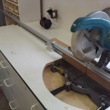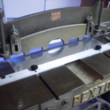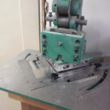Home : Dalrun :
 This mitersaw fence is used for cutting wood and aluminum at 90 degrees, It capable of cutting anything from 3/4" to 70" long. It is made from African Mahogany and t-slot extrusion (1010). The extrusion is mounted to the Mahogany with self-aligning t-slot nuts and to the saw with knurled nuts. The far end of the extrusion is mounted to the workbench in a similar manner.
This mitersaw fence is used for cutting wood and aluminum at 90 degrees, It capable of cutting anything from 3/4" to 70" long. It is made from African Mahogany and t-slot extrusion (1010). The extrusion is mounted to the Mahogany with self-aligning t-slot nuts and to the saw with knurled nuts. The far end of the extrusion is mounted to the workbench in a similar manner.
The stop is a self-squaring block stop with an angle spacer for reading the scale mounted to the top of the extrusion. The stop has a spindle that can be extended when cutting short pieces with the aid of a toggle clamp mounted to the fence.
[ page | top ]
 My original fence for this machine is a t-slot extrusion partially embedded in the table, The bolt head at the front of the table is used to adjust the the distance between the fence and boring head. The extrusion has alternating reamed and threaded holes to allow moving the stops in 32mm increments from the head.
My original fence for this machine is a t-slot extrusion partially embedded in the table, The bolt head at the front of the table is used to adjust the the distance between the fence and boring head. The extrusion has alternating reamed and threaded holes to allow moving the stops in 32mm increments from the head.
The new fence mounts to t-slot extrusions mounted to the sides of the table. This allows the machine to be used for other things, e.g. drilling/setting drawer front adjusters. Like my stops, the fence mounts use self squaring t-slot nuts to keep the fence parallel to the table and to allow the fence to be free sliding or incremental. Scales are handy in either case... The fence has holes 32mm apart for locating push stops that have 1mm per turn and .17mm per facet adjustability. While I've used paint marks in the past, I used a spring punch to mark 0mm with the stop fully retracted - full millimeters when the stop is adjusted out.
[ comment | link | top ]
 The fence on my 24" box and pan break is a piece of 2 x 3/16" aluminum that mounts to two t-slot extrusion arms. The aluminum has press fit dowel pins that mate with self-squaring t-slot nuts in the arms. The arms are mounted to the break body with two screws each. I used a dowel jig/drill bushings to insure the arms were mounted square/parallel. The sub-fence is a removable strip of stainless steel that allows making really short bends. The screws that clamp the fence to the arms have 5/16" drill rod heads (flat on the bottom). The drill rod head provides needed clearance and can be tightened with an open end wrench.
The fence on my 24" box and pan break is a piece of 2 x 3/16" aluminum that mounts to two t-slot extrusion arms. The aluminum has press fit dowel pins that mate with self-squaring t-slot nuts in the arms. The arms are mounted to the break body with two screws each. I used a dowel jig/drill bushings to insure the arms were mounted square/parallel. The sub-fence is a removable strip of stainless steel that allows making really short bends. The screws that clamp the fence to the arms have 5/16" drill rod heads (flat on the bottom). The drill rod head provides needed clearance and can be tightened with an open end wrench.
[ comment | link | top ]
 The table fence is 2 x 3/16" aluminum with 1/2" keystock mounted to the bottom. The keystock mates with the top of the T-slots in the table. The keystock has dowel pins that mate with 1/8" steel at the bottom of the T-slots. The knobs thread into the 1/8" steel and clamp the fence tight to the table. The t-slots are a bit rough, but the fence moves in and out pretty darn parallel to the shear. For accurately shearing narrow stock there are dowel pins set into the top of the fence that accept a modified depth stop caliper.
The table fence is 2 x 3/16" aluminum with 1/2" keystock mounted to the bottom. The keystock mates with the top of the T-slots in the table. The keystock has dowel pins that mate with 1/8" steel at the bottom of the T-slots. The knobs thread into the 1/8" steel and clamp the fence tight to the table. The t-slots are a bit rough, but the fence moves in and out pretty darn parallel to the shear. For accurately shearing narrow stock there are dowel pins set into the top of the fence that accept a modified depth stop caliper.
[ comment | link | top ]
 A slotted carpenters square fence, for shearing small stuff to size on a sheet metal notcher, and fences/stops for notching. Both register off the shear blades and rely on the squareness of the blades (not perfect) and fences/stops.
A slotted carpenters square fence, for shearing small stuff to size on a sheet metal notcher, and fences/stops for notching. Both register off the shear blades and rely on the squareness of the blades (not perfect) and fences/stops.
[ comment | link | top ]
Fences
Some machine fences I've made and use.
![]()
Mitersaw
 This mitersaw fence is used for cutting wood and aluminum at 90 degrees, It capable of cutting anything from 3/4" to 70" long. It is made from African Mahogany and t-slot extrusion (1010). The extrusion is mounted to the Mahogany with self-aligning t-slot nuts and to the saw with knurled nuts. The far end of the extrusion is mounted to the workbench in a similar manner.
This mitersaw fence is used for cutting wood and aluminum at 90 degrees, It capable of cutting anything from 3/4" to 70" long. It is made from African Mahogany and t-slot extrusion (1010). The extrusion is mounted to the Mahogany with self-aligning t-slot nuts and to the saw with knurled nuts. The far end of the extrusion is mounted to the workbench in a similar manner.The stop is a self-squaring block stop with an angle spacer for reading the scale mounted to the top of the extrusion. The stop has a spindle that can be extended when cutting short pieces with the aid of a toggle clamp mounted to the fence.
[ page | top ]
Hinge Boring Machine
 My original fence for this machine is a t-slot extrusion partially embedded in the table, The bolt head at the front of the table is used to adjust the the distance between the fence and boring head. The extrusion has alternating reamed and threaded holes to allow moving the stops in 32mm increments from the head.
My original fence for this machine is a t-slot extrusion partially embedded in the table, The bolt head at the front of the table is used to adjust the the distance between the fence and boring head. The extrusion has alternating reamed and threaded holes to allow moving the stops in 32mm increments from the head.The new fence mounts to t-slot extrusions mounted to the sides of the table. This allows the machine to be used for other things, e.g. drilling/setting drawer front adjusters. Like my stops, the fence mounts use self squaring t-slot nuts to keep the fence parallel to the table and to allow the fence to be free sliding or incremental. Scales are handy in either case... The fence has holes 32mm apart for locating push stops that have 1mm per turn and .17mm per facet adjustability. While I've used paint marks in the past, I used a spring punch to mark 0mm with the stop fully retracted - full millimeters when the stop is adjusted out.
[ comment | link | top ]
Sheet Metal Box Break
 The fence on my 24" box and pan break is a piece of 2 x 3/16" aluminum that mounts to two t-slot extrusion arms. The aluminum has press fit dowel pins that mate with self-squaring t-slot nuts in the arms. The arms are mounted to the break body with two screws each. I used a dowel jig/drill bushings to insure the arms were mounted square/parallel. The sub-fence is a removable strip of stainless steel that allows making really short bends. The screws that clamp the fence to the arms have 5/16" drill rod heads (flat on the bottom). The drill rod head provides needed clearance and can be tightened with an open end wrench.
The fence on my 24" box and pan break is a piece of 2 x 3/16" aluminum that mounts to two t-slot extrusion arms. The aluminum has press fit dowel pins that mate with self-squaring t-slot nuts in the arms. The arms are mounted to the break body with two screws each. I used a dowel jig/drill bushings to insure the arms were mounted square/parallel. The sub-fence is a removable strip of stainless steel that allows making really short bends. The screws that clamp the fence to the arms have 5/16" drill rod heads (flat on the bottom). The drill rod head provides needed clearance and can be tightened with an open end wrench.
[ comment | link | top ]
Sheet Metal Shear
 The table fence is 2 x 3/16" aluminum with 1/2" keystock mounted to the bottom. The keystock mates with the top of the T-slots in the table. The keystock has dowel pins that mate with 1/8" steel at the bottom of the T-slots. The knobs thread into the 1/8" steel and clamp the fence tight to the table. The t-slots are a bit rough, but the fence moves in and out pretty darn parallel to the shear. For accurately shearing narrow stock there are dowel pins set into the top of the fence that accept a modified depth stop caliper.
The table fence is 2 x 3/16" aluminum with 1/2" keystock mounted to the bottom. The keystock mates with the top of the T-slots in the table. The keystock has dowel pins that mate with 1/8" steel at the bottom of the T-slots. The knobs thread into the 1/8" steel and clamp the fence tight to the table. The t-slots are a bit rough, but the fence moves in and out pretty darn parallel to the shear. For accurately shearing narrow stock there are dowel pins set into the top of the fence that accept a modified depth stop caliper.
[ comment | link | top ]
Sheet Metal Notcher
 A slotted carpenters square fence, for shearing small stuff to size on a sheet metal notcher, and fences/stops for notching. Both register off the shear blades and rely on the squareness of the blades (not perfect) and fences/stops.
A slotted carpenters square fence, for shearing small stuff to size on a sheet metal notcher, and fences/stops for notching. Both register off the shear blades and rely on the squareness of the blades (not perfect) and fences/stops.
[ comment | link | top ]
